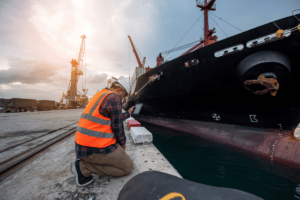Offshore maritime jobs play a vital role in America’s economy, but they are among the most dangerous on Earth. The natural environment where oil rigs, natural gas wells, and other offshore facilities are located is often harsh and unforgiving. In addition, workers are at risk of offshore maritime injuries and accidents caused by defective equipment, unseaworthy vessels, and negligence by employers, vessel owners, or fellow offshore workers. Poor maintenance, lack of proper safety measures, and unsafe work practices often cause fatal explosions, fires, and blowout incidents such as the Deepwater Horizon disaster in April of 2010.

Risky Business: Offshore Maritime Accidents
In April 2010, the Deepwater Horizon oil rig owned by British Petroleum (BP) exploded as a result of a blowout at the Macondo Project in the Gulf of Mexico. Of the 126 oil rig workers aboard, 11 died and 16 were injured. The resulting oil spill was the largest in U.S. history and the rig was a total loss.
The Deepwater Horizon disaster looms large in the public eye because the environmental damage it caused will linger for many years. However, disasters still occur in offshore maritime facilities all over the world. In June of 2013, an offshore support vessel named Celeste Ann sank in the Gulf of Mexico after colliding with an oil rig. None of the 22 persons aboard were seriously injured, but the Celeste Ann went to the bottom of the sea.
A few weeks later, one oil rig worker was declared missing and presumed dead after the jack-up rig Perro Negro 6 sank off the coast of Angola on July 1. The seabed under one of the rig’s three legs collapsed and caused the jack-up rig to plummet into the Atlantic. Six of the missing oil rig worker’s fellow crew members suffered minor injuries. On July 24, another jack-up rig, the Hercules 265, caught fire in the Gulf of Mexico after a blowout similar to the one that destroyed Deepwater Horizon. Fortunately, the Hercules 265 had no crew aboard, but the rig sank.
Not all offshore maritime injuries have to be catastrophic to cause injuries. There are many incidents beyond explosions, fires, or sinking that can hurt, disable, or even kill offshore workers and seamen.
Most Common Offshore Accidents
- Falling objects
- Workers hit by cranes or other heavy equipment
- Slips, trips and falls
- Falls overboard
- Exposure to toxic materials
- Exposure to extreme temperatures
Offshore Maritime Injuries
Workers on oil rigs, natural gas wells, and their support vessels are at risk of suffering offshore maritime injuries on the job due to the nature of their occupation and where they work. Even in good weather and calm seas, seamen and other maritime workers can get hurt, especially if the negligence of others causes an accident. To make matters worse, offshore workers live and do their jobs far from the nearest first responders or medical facilities. If an accident occurs, it sometimes takes hours for help to arrive via Coast Guard vessels or helicopters. Follow this link To learn more about Offshore Injury Lawyers.
These are the most common injuries suffered by seamen and other workers in the offshore maritime industry:
- Spinal cord injuries
- Burns
- Scarring
- Traumatic brain injuries
- Head injuries
- Loss of limbs
- Lacerations
- Broken bones
- Crushed limbs
- Lung damage from chemical fumes or smoke inhalation
Workers who suffer injuries while working on offshore facilities not only risk losing time from work and earning potential, but they may also suffer permanently disability. In the worst of cases, an accident on a jack-up rig, drilling ship, or a support vessel can be fatal.
Getting Compensation for Offshore Maritime Injuries
Offshore maritime workers who suffer injuries on the job have protections under general maritime law and two specific compensation laws. These include the Jones Act and the Longshore and Harbor Workers’ Compensation Act.
The Jones Act applies to seamen who work on jack-up rigs and other mobile oil extraction vessels such as drill ships. It gives injured seamen the right to file claims against captains, ship owners, or fellow crew members if the offshore maritime injuries were caused by negligence or if the support vessels or mobile rigs were unseaworthy.
Although they’re not covered by the Jones Act, workers on stationary oil rigs and natural gas wells are covered by either state worker compensation plans or the federal government’s LHWCA, depending on the accident site’s geographical location and jurisdiction. The LHWCA provides occupational injury and disease protection to workers who are hurt or contract illnesses on navigable waters of the U.S., adjoining areas. Also, certain classes of workers have coverage by extensions to the LHWCA.